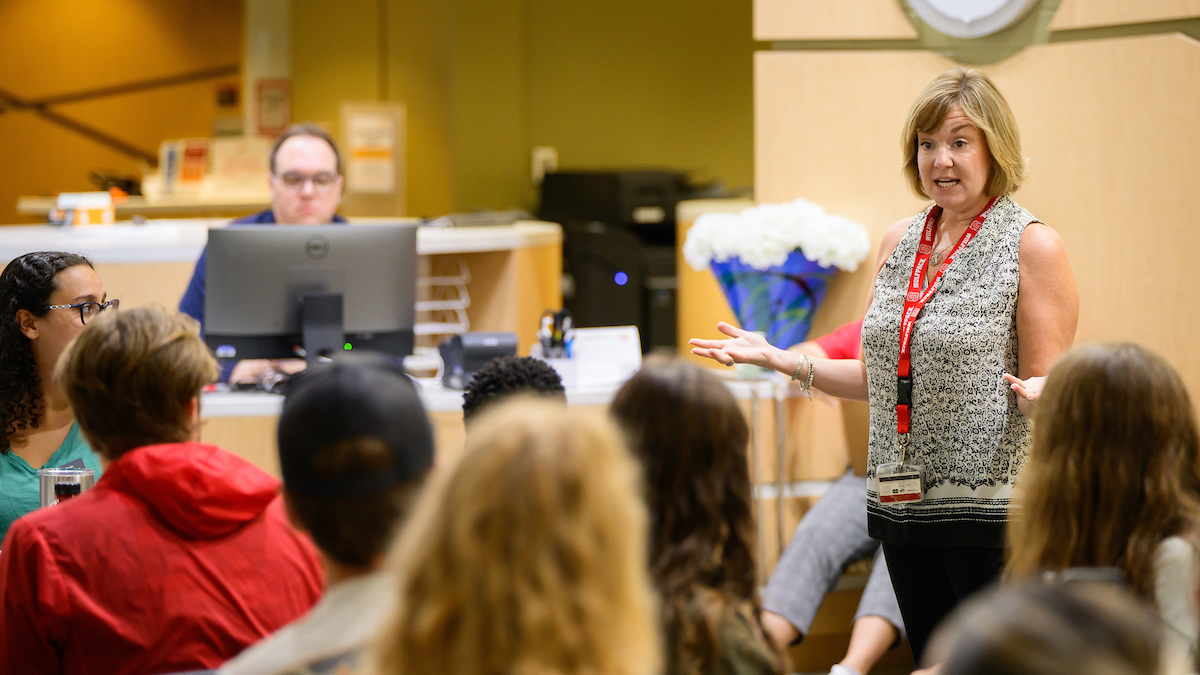From Classrooms to Cows in Under 60 Seconds
A working farm called the Teaching Animal Unit puts extraordinary learning experiences right at students’ fingertips.

Just outside the back doors of the NC State College of Veterinary Medicine, where classrooms and labs and lockers line the halls, 80 picturesque acres provide a home for pigs, chickens, sheep, goats and cattle and a learning lab for veterinary students.
The Teaching Animal Unit, as the working farm is known, is a dynamic space for students to learn husbandry, production management and procedures used routinely in livestock production. Few, if any, other colleges have anything quite like it.
Part of what makes it special is that students can observe and work with a range of agricultural animals in a real farm setting, all within walking distance of their regular classrooms. What happens beneath the farm’s historic silos also provides many a cherished memory for CVM graduates.
“There’s nothing else like NC State,” says Danielle Mzyk, a Chapel Hill native and an alumna who earned both her veterinary degree and a Ph.D. in pharmacology at the college. “I looked at a lot of campuses before coming to NC State. As a student I could go to class in the morning and then go see a foal being born during lunch. I wanted to build a future as a mixed animal veterinarian, and the TAU gave me that opportunity.”
Generations of veterinarians have been able to take advantage of the Teaching Animal Unit’s unique presence.
“I’m a milker,” says Jaime Calcago, a second-year veterinary student who also works on the farm’s staff. “I milk 18 to 20 dairy cattle a day, clean up afterward and drop their post-milking feed. Working at the TAU is the kind of experience working with large animals that I couldn’t get elsewhere. It’s amazing to see a dairy cow give birth. I really learned about life from that.”
What’s more, an ambitious 11-year master plan completed in 2017 calls for upgrades and improvements that will see to it that the TAU continues to be a dynamic, relevant part of veterinary education for generations to come.
“The TAU is a big part of our overall strength,” says Kate Meurs, dean of the College of Veterinary Medicine. “A six-phased plan for renovation and improvement will upgrade our practices and help modernize our teaching. It’s part of our approach of continuous innovation to remain on the cutting edge of veterinary medicine.”
“The TAU is a big part of our overall strength,” says Kate Meurs, dean of the College of Veterinary Medicine. “A six-phased plan for renovation and improvement will upgrade our practices and help modernize our teaching.”
Phase one of the plan kicked off in November when the college broke ground on a new $5.5 million dairy barn that will lead to students learning the latest in food safety and security practices as well as a modern approach to animal welfare.
Students have labs at the farm during their first three years and make visits as part of their senior rotations during year four. The Teaching Animal Unit has six subunits that reflect the principal food animal groups.
“That includes experiences with swine, poultry, sheep, goats, beef and dairy cattle,” explains Sara Beth Routh, director of the unit. “The new dairy facility will add a much-needed improvement, meeting current industry standards to provide a safe learning environment for students, a safe working environment for staff and improved housing for animals.”

In addition to assigned academic activities, some students gain more practical experience by working as members of the farm staff.
“TAU plays a huge role in the education of our student employees,” Routh says, “providing increased hands-on learning about best practices in animal husbandry. This includes, but isn’t limited to, daily care, low stress handling, animal behavior, milking dairy cows, assisting with births, administration of medications and techniques associated with the various species on site.”
To NC State veterinary students, the unit is about more than their professional education. It’s about making memories, too.
“In the spring it was a great stress reliever to be able to snuggle with the baby goats during a break,” Mzyk says.
For Mzyk and so many others, it was those little things as well as the big things they experienced at the TAU that inform their work life today. Mzyk now works at an animal practice that sees both pets and farm animals in a small Wisconsin town.
Associate Dean Laura Nelson adds that having the Teaching Animal Unit right outside the college’s door is an amazing asset not only for the students but also for the entire profession.
“With our location in the middle of a rapidly growing metro area, the opportunity for our students to spend time learning on a working farm that is on our campus from the first year of their curriculum onward is tremendous,” says Nelson, director of Academic Affairs. “Experience at the TAU has changed career trajectories. Those careers, in turn, have had big impacts on the veterinary profession.”



